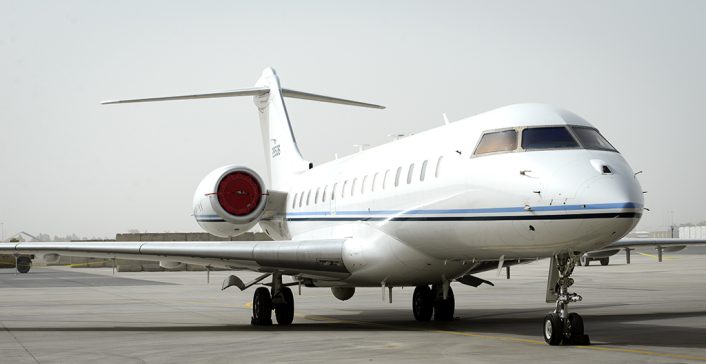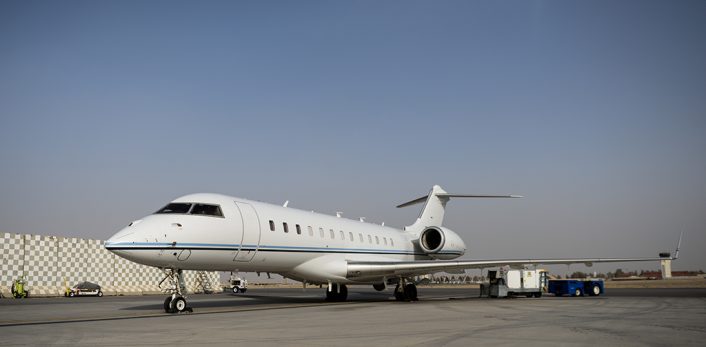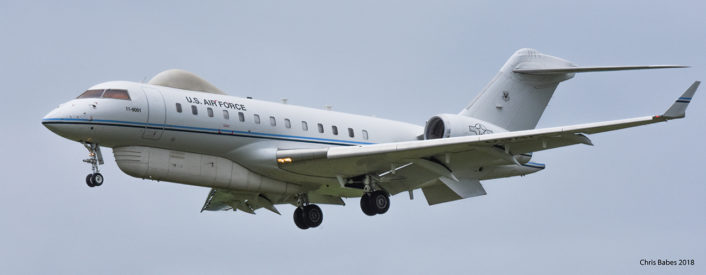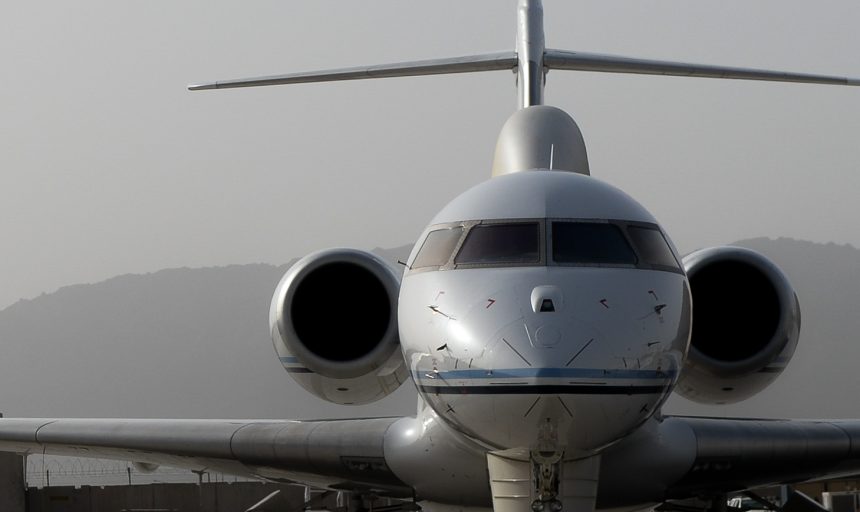Commonly known as Battlefield Airborne Communications Node, or BACN, the E-11A is a U.S. Air Force aircraft that provides unparalleled communications capabilities to coalition forces on the ground and aircraft in the air.
“There is an aircraft that is so unique, you can only find it in one place – not even the pilots who fly the aircraft can touch it until they are deployed to this specific location,” says a recent U.S. Air Force article.
That aircraft is the E-11A (Bombardier Global 6000 advanced ultra long-range business jets that have been modified by the U.S. Air Force to accomodate Battlefield Airborne Communications Node payload). All of the four U.S. Air Force’s E-11A aircraft with the BACN payload are assigned to the 430th Expeditionary Electronic Combat Squadron and operate solely out of Kandahar Airfield.

Missions flown by the BACN platforms (E-11A and EQ-4 assigned to 380th Air Expeditionary Wing based at Al Dhafra Air Base to support Operation Inherent Resolve) are extremely important: they act as a technological “gateway” system that allows aircraft with incompatible radio systems and datalinks to transfer information and communicate.
Here’s what this Author wrote about BACN in a previous article:
The U.S. military uses various datalink systems to exchange tactical information, and many are not capable of working together. For example, a U.S. Air Force F-15 can use its Link-16 system to exchange target information with a U.S. Navy F/A-18. However, the F/A-18 could not exchange information with a USAF B-52 or B-1 bomber. The advanced F-22 can connect with other Raptors via datalink but can only receive over the standard, legacy Link-16 datalink used by most allied aircraft.
This lack of compatibility between different platforms is a major obstacle in all those theaters where air assets from many services are called upon to provide support for ground troops of different nations. Additionally, the complicated joint operations required to engage a modern integrated air defense system are greatly simplified by exchanging target information via datalinks.
Hence the need for a “flying gateway” as the EQ-4.
The BACN system is also used to link ground troops and Forward Air Controllers (FACs)/Joint Terminal Attack Controllers in a non-line-of-sight (LOS) environment. For instance, in the rugged, mountainous terrain of Afghanistan, troops are not always able to establish LOS communications with close support aircraft overhead. Moving position or relocating to higher ground could be fatal in a combat situation.
According to the U.S. Air Force, the BACN was developed in direct response to the communication shortfalls during Operation Red Wings, a joint U.S. military mission in Kunar Province, Afghanistan in 2005, famous following the success of the book and subsequent movie “Lone Survivor” by Marcus Luttrell, a former SEAL and the only surviving member of the mission. “Due to Afghanistan’s mountainous terrain and lack of existing communication infrastructure, serious communication challenges prevented the four-man SEAL patrol from effectively establishing contact with their combat operations center, leaving them vulnerable to the attacks that claimed the lives of 19 U.S. special operations service members.”
BACN “is like Wi-Fi in the sky,” explained U.S. Air Force Capt. Jacob Breth, 430th EECS pilot, in an official news release.
Noteworthy, Breth is a C-130J Super Hercules pilot from Ramstein Air Base, Germany; in fact all the pilots assigned to fly the E-11A aircraft take to the skies for the first time while deployed. The training for the E-11A requires a month in the high-fidelity flight simulator that makes flying the actual plane like second-nature, and about a week of in-theater indoctrination training.
E-11A aircraft of the 430th Expeditionary Electronic Squadron deployed to Kandahar Airfield, a geographically separated unit of the 455th Air Expeditionary Wing headquartered at Bagram Airfield, Afghanistan, have been involved in missions over Afghanistan (some of those trackable on the Internet as highlighted several times) since they arrived in theater for the first time 9 years ago: by orbiting at high-altitude for long times, these assets can provide a communications link from ground commanders to the CAS (Close Air Support) aircraft. For example, a legacy USAF A-10 attack aircraft could loiter away from a battle area while using the BACN link to communicate with a special-forces FAC on the ground. The A-10 pilot could wait until all targeting information is ready before “un-masking” and beginning an attack run.

Update Nov. 27, 2018 23.30 GMT
One of our readers provided flight data for E-11A movements through Europe in the last four years. See the list below. There is an interesting pattern noticeable that each aircraft does a deployment of about one year before transitioning back to the US via Europe for a short while before returning back on station. This is probably for a base maintenance check. Frequently, they use the cover of darkness but that might also be an coincidence.
| Date | Callsign | Origin | Destination | Type | Registration |
| 10-02-2015 | VELCRO5 | OAKN | EGUN | GLEX | 11-9358 |
| 11-02-2015 | VELCRO5 | EGUN | KICT | GLEX | 11-9358 |
| 21-03-2015 | VELCRO5 | KICT | EGUN | GLEX | 11-9358 |
| 22-03-2015 | VELCRO5 | EGUN | OAKN | GLEX | 11-9358 |
| 26-10-2015 | VELCRO5 | OAKN | ETAR | GLEX | 11-9001 |
| 27-10-2015 | VELCRO5 | ETAR | KMTN | GLEX | 11-9001 |
| 06-12-2015 | VELCRO5 | KBGR | ETAR | GLEX | 11-9001 |
| 07-12-2015 | VELCRO5 | ETAR | OAKN | GLEX | 11-9001 |
| 08-05-2016 | VELCRO5 | OAKN | ETAR | GL5T | 12-9506 |
| 09-05-2016 | VELCRO5 | ETAR | KICT | GL5T | 12-9506 |
| 18-05-2016 | VELCRO5 | KICT | ETAR | GL5T | 12-9506 |
| 20-05-2016 | VELCRO5 | ETAR | OAKN | GL5T | 12-9506 |
| 16-07-2016 | VELCRO5 | OAKN | ETAR | GLEX | 11-9355 |
| 17-07-2016 | VELCRO5 | ETAR | KBGR | GLEX | 11-9355 |
| 18-08-2016 | VELCRO5 | KICT | ETAR | GLEX | 11-9355 |
| 20-08-2016 | VELCRO5 | ETAR | OAKN | GLEX | 11-9355 |
| 20-10-2016 | VELCRO5 | OAKN | ETAR | GLEX | 11-9001 |
| 21-10-2016 | VELCRO5 | ETAR | CYQX | GLEX | 11-9001 |
| 27-01-2017 | VELCRO5 | KBGR | LERT | GLEX | 11-9001 |
| 28-01-2017 | VELCRO5 | LERT | OAKN | GLEX | 11-9001 |
| 14-04-2018 | VELCR04 | OAKN | EGAA | GLEX | 11-9358 |
| 14-04-2018 | VELCR04 | EGAA | KIAB | GLEX | 11-9358 |
| 30-06-2018 | VELCRO4 | KICT | EGUN | GLEX | 12-9506 |
| 04-07-2018 | VELCRO4 | EGUN | OAKN | GLEX | 12-9506 |
| 06-07-2018 | VELCRO4 | OAKN | ETAR | GLEX | 11-9355 |
| 06-07-2018 | VELCRO4 | ETAR | KADW | GLEX | 11-9355 |
| 20-07-2018 | VELCRO4 | KICT | EGUN | GLEX | 11-9355 |
| 22-07-2018 | VELCRO4 | EGUN | OAKN | GLEX | 11-9355 |
| 29-07-2018 | VELCRO4 | OAKN | EGAA | GLEX | 11-9001 |
| 29-07-2018 | VELCRO4 | EGAA | KBED | GLEX | 11-9001 |
| 03-09-2018 | VELCRO4 | KICT | EGUN | GLEX | 11-9001 |
| 04-09-2018 | VELCRO4 | EGUN | OAKN | GLEX | 11-9001 |










